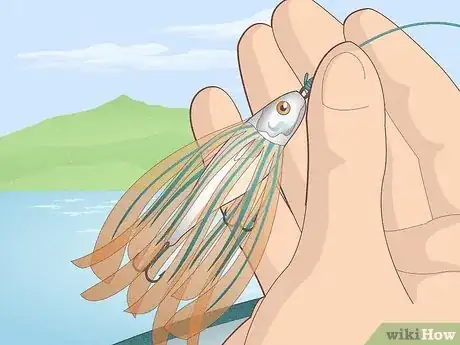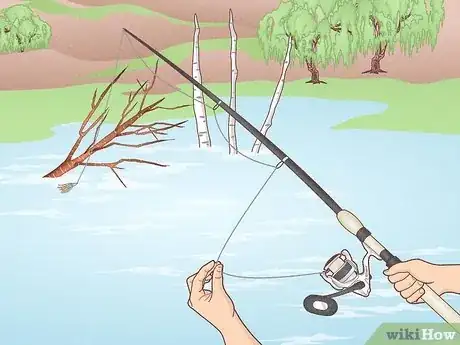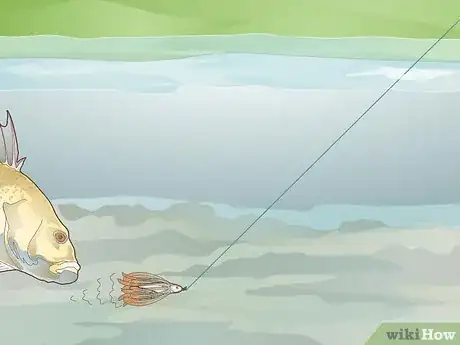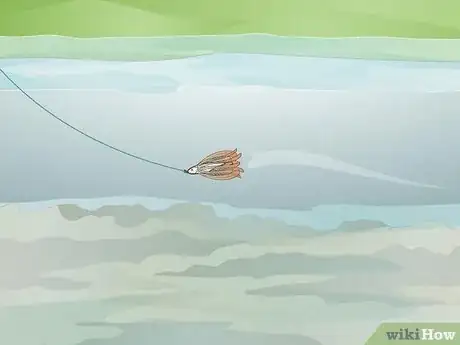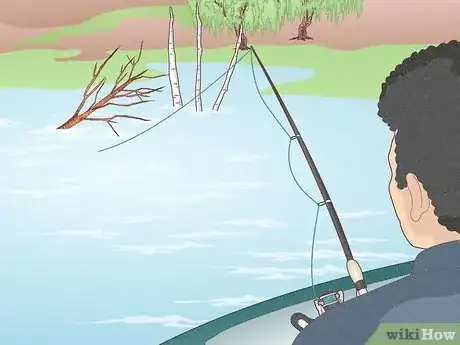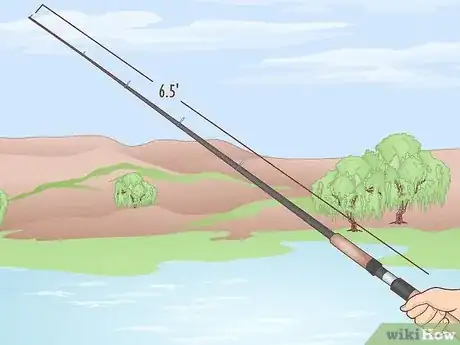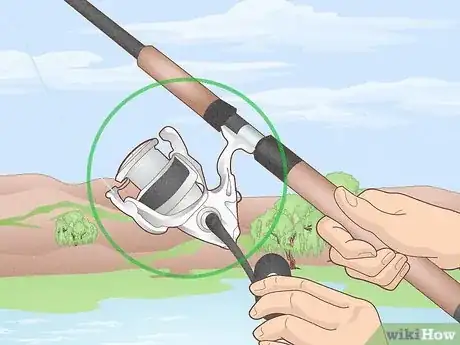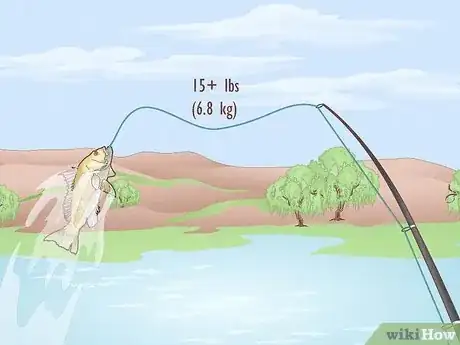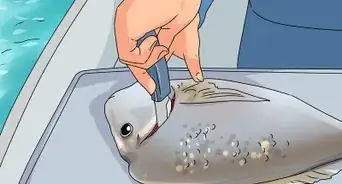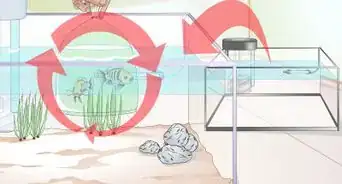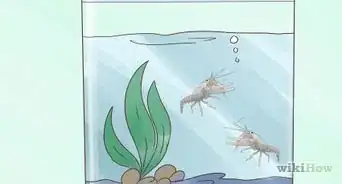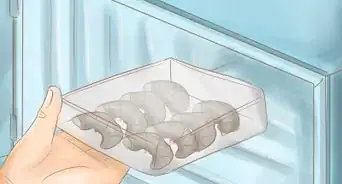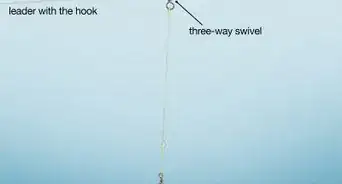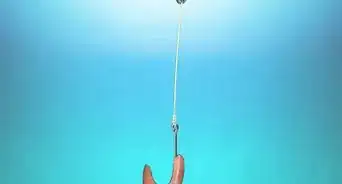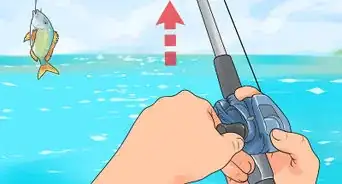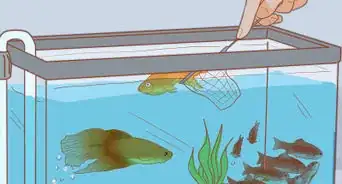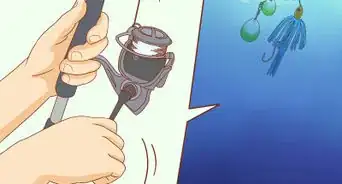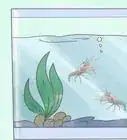This article was co-authored by wikiHow staff writer, Dan Hickey. Dan Hickey is a Writer and Humorist based in Chicago, Illinois. He has published pieces on a variety of online satire sites and has been a member of the wikiHow team since 2022. A former teaching artist at a community music school, Dan enjoys helping people learn new skills they never thought they could master. He graduated with a BM in Clarinet Performance from DePauw University in 2015 and an MM from DePaul University in 2017.
There are 10 references cited in this article, which can be found at the bottom of the page.
This article has been viewed 1,831 times.
Learn more...
Fishing a jig is one of the most common, versatile, and effective ways to catch bass. It works in large and small bodies of water in a variety of environments and makes for a fun and relaxing pastime. If you’re wondering how to hook a bass with a jig, you’re in the right place! We’ve put together a list of the best techniques for casting and fishing your jig, as well as a guide to selecting the right equipment for maximum success. Happy fishing!
Steps
Casting Techniques
-
1Select a jig designed to work in your fishing environment. Jigs can be customized to work in any circumstance. They usually have one hook weighed down by a heavy lead head, with a rubber skirt or hair around the hook to disguise it or prevent catching on weeds.[1] In murky or dense water, choose a heavy jig (around 0.75 ounces (21 g)) and in light water, choose a lighter jig (around 0.25 ounces (7.1 g)).[2] Attach a jig to your line with a loop knot. Here are the most common types of jigs to choose from:
- A swim jig is designed to cut through grass and wood. Instead of dragging it along the bottom of the water, it should stay moving in open water.
- A football jig is great for offshore fishing and works best when it’s dragged along the bottom of the lake, pond, or river.
- Flipping jigs are good for precise aiming in shallow wood, shoreline grass, and docks.
- Punch jigs are designed to punch through matted grass. It’s a good option when you want a really bulky, fast-sinking presentation.
- A finesse jig is used for precise targeting and are fished slowly with soft tugs and short lifts of the rod tip.
- A casting jig is an all-purpose jig that can be used in a variety of environments and with many different fishing techniques.
-
2Pitch your jig when there's overhanging cover like docks or branches. Pitching is a quiet and accurate way to cast without spooking the bass. It’s like underhand throwing your jig into the water while you let the line feed through the guides on the rod. A lighter bait works with pitching to avoid scaring the fish.[3] Position yourself 10 feet (3.0 m) to 20 feet (6.1 m) away from your target and follow these steps to pitch:
- Press the release button on your spool with one hand and grab the bait (or the line just above the bait) with your opposite hand.
- Pull the bait back and aim at your target with the tip of the rod.
- Toss the bait and release the spool at the same time. Let the line flow freely.
- Use the rod tip to slow down the bait so it hits the water gently.
Advertisement -
3Flip your jig into tough-to-reach spots where bass like to hide. Use this technique in shallow water to reach areas between boat lifts or submerged trees where normal casting is too difficult.[4] Position yourself a few rod lengths away from your target and follow these steps to flip your jig:
- Release the line by pulling out between the reel and the first rod guide (pull out enough line to reach your target). Set this extra line down on the ground (not the water).
- Press your thumb down on the spool and release button like a normal cast. With your other hand, pinch the line between the reel and first guide.
- Lift your rod to the 12 o’clock position and let the bait dangle.
- Slowly swing the bait back and forth like a pendulum in the direction of your target.
- Release the line at the top of the swing.
Retrieval Techniques
-
1Punch your jig when you’re fishing in dense cover. Punching is an aggressive movement of the jig to attract bass’s attention. It works best in shallower water where weeds, brush, wood, or boulders provide cover for the bass. After casting, wait a few seconds or until you feel your jig hit the bottom. Then, quickly snap the tip of the rod upwards so the jig is jerked about 2 feet (0.61 m) to 3 feet (0.91 m) through the cover. Let the jig slowly fall again and repeat.[5]
- Pause a few seconds between punches to let your jig settle. Punching gets the bass’s attention, but pausing gives them a chance to strike.
- Punching can be done in any direction—up and down, side to side, or diagonally.
-
2Drag your jig to search the bottom and tempt deep swimming bass. To drag, cast your jig very far—this gives you more water to search. Let the jig fall all the way to the bottom and use your rod to slowly drag the jig along the bottom. If vegetation keeps snagging your jig, hover it a few inches above the bottom instead of maintaining contact.[6]
- The deeper the water or stronger the currents are, the heavier of a jig you should use.
- Maintain a very steady, slow speed.
-
3Swim your jig to move smoothly through various depths. Cast out and begin reeling the jig back in slow and steady. Keep the rod positioned at 10 o’clock. Give the jig some intermittent pulls, especially if it gets caught on vegetation, to make it look erratic and entice bass to bite. A minnow or paddle tailed trailer that glides through water easily works well here.[7]
- Swimming can be done at any depth. It’s helpful to swim in between depths, usually going from deep toward the surface.
- Swim your jig along weed beds or transitions between deep water and shallow areas.
-
4Keep your eye on the line while you wait for a bite. You might not always feel a bass bite, especially if they’re towards the bottom. Watching the line is just as crucial as feeling a bite, especially for bass that try to grab the jig while it's falling. Look for a sudden jolt on the line at the top of the water. Engage the reel as fast as you can and take in the slack right away to reel in your bass![8]
- Remember, lighter jigs fall slower. They’re more likely to get bitten mid-descent than heavier ones.
- If your line goes even more slack than before, it means a fish has the bait and is swimming towards you.
- If visibility is bad, try a yellow or red line to help you watch its movement.
Choosing Gear
-
1Attach a trailer to your jig to further tempt the bass. A trailer is a plastic lure usually shaped like a craw or worm. Trailers give the jig more action (movement), fill out the profile of the bait, and add color to your setup. The type of trailer you choose depends on the environment you’re fishing in and how you want to cast the jig into the water.[9] Attach the trailer to your jig by punching the hook of the jig through the plastic of the trailer. Here are the most popular trailer types and their uses:
- Craw trailers look like a crawfish and have pincers on them. They make a loud and flappy presentation and work best in more open and clear water. A high-action craw works best in summer and fall when bass are moving more, and a low-action craw is better for winter and spring when they’ve slowed down.
- Minnow and paddle tail trailers (also called swimmers) are smaller than craws and mimic a small fish. They have similar action to a live bluegill or other bait fish. These are suited to finesse casting (aiming your jig with high precision).
- Grubs (also called worms or lizards) look like worms with a tail on them and cover the vertical section of the jig hook. They make an attractive disturbance in the water—more tails on the grub equals more action.
- The color of the trailer doesn’t necessarily have to match the color of the jig. Generally, warm days in summer call for bright-colored trailers (yellow, orange, pink), while cold, cloudy, or wintery days call for natural or matte colors like brown, navy, or black.[10]
-
2Choose a long, sensitive fishing rod. Long rods with a big range of motion at the tip work best with jigs. You’ll be lowering and raising the tip a lot to move the jig and tempt bass, so a length of at least 6.5 feet (2.0 m) is ideal. A sensitive rod with fast or medium action helps you feel the nibbles of the bass.[11]
- Opt for a graphite rod for bass. It’s a strong material that can reel in heavy bass, but it’s lightweight enough that you won’t tire your arms out.
- A light or medium weight rod works for smaller bass. If you’re fishing in an area with large bass, consider a heavier rod.
-
3Opt for a baitcasting reel to aim your jig accurately when you cast the line. The reel should be large (around 200 size) and have a fast retrieve speed—this helps you reel in your line quickly with less cranks of the handle. Look for a gear ratio of at least 6:1 or 7:1.[12]
- A fast reel helps prevent losing hooked fish while you pull them through thick cover like underwater weeds, logs, and muck.
-
4Use a braided fishing line. Braided line is strong enough to reel in heavy bass. It doesn’t stretch and is resistant to scratching or breaking on vegetation or other obstacles.[13] The line should be at least 15 pounds (6.8 kg), but if you’re fishing in areas with dense vegetation, choose a heavier line up to 40 pounds (18 kg) or 65 pounds (29 kg).[14]
References
- ↑ https://myodfw.com/articles/how-fish-bass
- ↑ https://www.bassresource.com/fish/jigs.html
- ↑ https://www.bassresource.com/fishing/flipping_pitching.html
- ↑ https://www.bassresource.com/fishing/flipping_pitching.html
- ↑ https://www.takemefishing.org/how-to-fish/fishing-with-lures/how-to-jig/
- ↑ https://www.outdoorsweekly.com/articles/dragging-jigs-for-river-walleye/
- ↑ https://www.bassresource.com/fish/jigs.html
- ↑ https://www.presspubs.com/kanabec/opinion/columns/fishing-tips-for-strike-detection/article_8916965e-73bd-11e3-8456-0019bb2963f4.html
- ↑ https://www.in-fisherman.com/editorial/jig-trailers-for-bass/368836
- ↑ https://www.bassresource.com/fish/jigs.html
- ↑ https://www.bassresource.com/beginner/bass_fishing_rods.html
- ↑ https://sportfishingbuddy.com/bass-jig-rod-setup/
- ↑ https://www.iowadnr.gov/fishing/fishing-tips-how-tos/how-to-fish-for-/largemouth-bass-fishing
- ↑ https://sportfishingbuddy.com/bass-jig-rod-setup/
